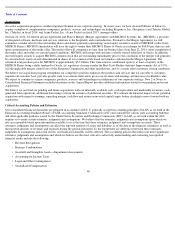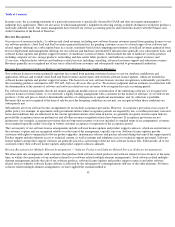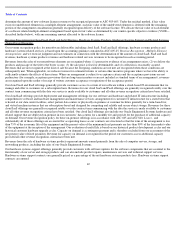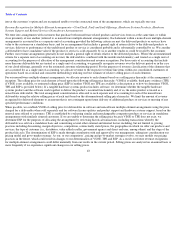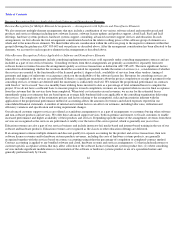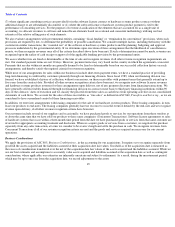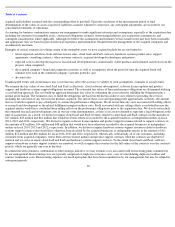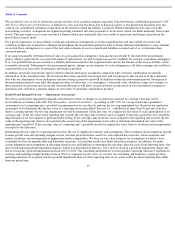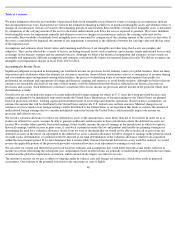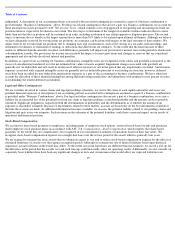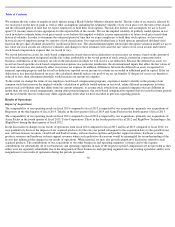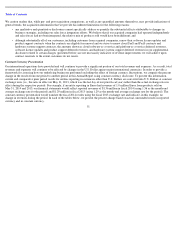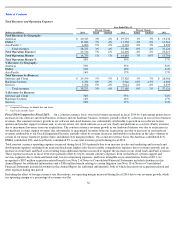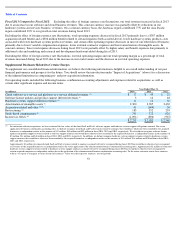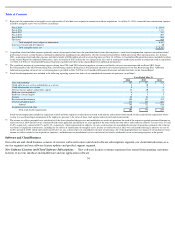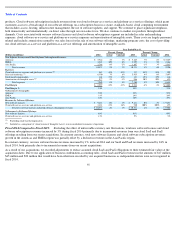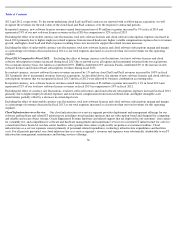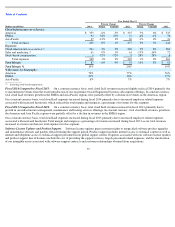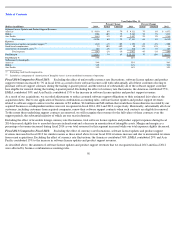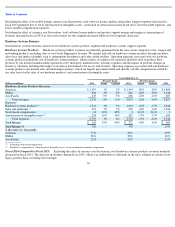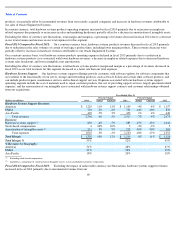Oracle 2013 Annual Report Download - page 54
Download and view the complete annual report
Please find page 54 of the 2013 Oracle annual report below. You can navigate through the pages in the report by either clicking on the pages listed below, or by using the keyword search tool below to find specific information within the annual report.
Table of Contents
We estimate the fair values of employee stock options using a Black-Scholes-Merton valuation model. The fair value of an award is affected by
our stock price on the date of grant as well as other assumptions including the estimated volatility of our stock price over the term of the awards
and the estimated period of time that we expect employees to hold their stock options. The risk-free interest rate assumption we use is based
upon U.S. treasury interest rates appropriate for the expected life of the awards. We use the implied volatility of publicly traded options in our
stock in order to estimate future stock price trends as we believe that implied volatility is more representative of future stock price trends than
historical volatility. In order to determine the estimated period of time that we expect employees to hold their stock options, we have used
historical rates of employee groups by seniority of job classification. Our expected dividend rate is based upon an annualized dividend yield
based on the per share dividend declared by our Board of Directors. The aforementioned inputs entered into the option valuation model we use to
fair value our stock awards are subjective estimates and changes to these estimates will cause the fair values of our stock awards and related
stock-based compensation expense that we record to vary.
We record deferred tax assets for stock-based compensation awards that result in deductions on our income tax returns, based on the amount of
stock-based compensation recognized and the fair values attributable to the vested portion of stock awards assumed in connection with a
business combination, at the statutory tax rate in the jurisdiction in which we will receive a tax deduction. Because the deferred tax assets we
record are based upon the stock-based compensation expenses in a particular jurisdiction, the aforementioned inputs that affect the fair values of
our stock awards may also indirectly affect our income tax expense. In addition, differences between the deferred tax assets recognized for
financial reporting purposes and the actual tax deduction reported on our income tax returns are recorded in additional paid-in capital. If the tax
deduction is less than the deferred tax asset, the calculated shortfall reduces our pool of excess tax benefits. If the pool of excess tax benefits is
reduced to zero, then subsequent shortfalls would increase our income tax expense.
To the extent we change the terms of our employee stock-based compensation programs, experience market volatility in the pricing of our
common stock that increases the implied volatility calculation of publicly traded options in our stock, refine different assumptions in future
periods such as forfeiture rates that differ from our current estimates, or assume stock awards from acquired companies that are different in
nature than our stock award arrangements, among other potential impacts, the stock-
based compensation expense that we record in future periods
and the tax benefits that we realize may differ significantly from what we have recorded in previous reporting periods.
Results of Operations
Impact of Acquisitions
The comparability of our operating results in fiscal 2014 compared to fiscal 2013 is impacted by our acquisitions, primarily our acquisitions of
Responsys in the third quarter of fiscal 2014, Tekelec in the first quarter of fiscal 2014 and Acme Packet in the fourth quarter of fiscal 2013.
The comparability of our operating results in fiscal 2013 compared to fiscal 2012 is impacted by our acquisitions, primarily our acquisitions of
Acme Packet in the fourth quarter of fiscal 2013, Taleo Corporation (Taleo) in the fourth quarter of fiscal 2012 and RightNow Technologies, Inc.
(RightNow) during the third quarter of fiscal 2012.
In our discussion of changes in our results of operations from fiscal 2014 compared to fiscal 2013 and fiscal 2013 compared to fiscal 2012, we
may qualitatively disclose the impacts of our acquired products (for the one year period subsequent to the acquisition date) to the growth in our
new software licenses revenues, cloud SaaS and PaaS revenues, software license updates and product support revenues, hardware systems
products revenues and hardware systems support revenues where such qualitative discussions would be meaningful for an understanding of the
factors that influenced the changes in our results of operations. When material, we may also provide quantitative disclosures related to such
acquired products. The contributions of our acquisitions to our other businesses and operating segments’ revenues and to the expense
contributions for substantially all of our businesses and operating segments in each of the respective period comparisons are not provided as they
either were not separately identifiable due to the integration of these businesses and operating segments into our existing operations and/or were
insignificant to our results of operations during the periods presented.
50


